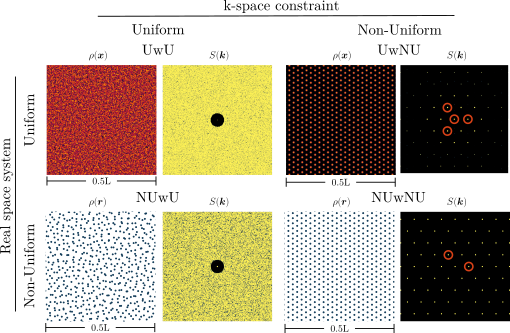Fast Reciprocal Space Correlator
FReSCo is a Python package (written in c++ and wrapped with cython) to impose reciprocal-space (aka Fourier-space, k-space) constraints on a real space system. For example, starting from a random point pattern, we can adjust the positions of the points to find a point pattern whose structure factor looks like Van Gogh's Starry Night:
This is achievable in quasilinear time largely due to the FINUFFT package https://finufft.readthedocs.io/en/latest/index.html. We borrow their formalism to describe our real- and reciprocal-spaces as 'uniform' (i.e. a grid of intensity values) and 'non-uniform' (a set of point coordinates in continuous space).
Below, we show our algorithm's handling of all permutations of real- and reciprocal-spaces.
For uniform reciprocal-space examples, the imposed structure factor was
We recommend reading our preprint Fast Generation of Spectrally-Shaped Disorder at https://arxiv.org/abs/2305.15693 for more in-depth details of our algorithm. We also have a video submission to the DSOFT Gallery of Soft Matter here.
We recommend installing using a Docker container. In particular, it is by far the easiest solution on MacOS. The Dockerfile contains the minimal setup for the container. To build a container called frescontainer with a cloned, simply run
./docker_build.shThis may take a few minutes on the first build. Then, either run
./docker_starter.shto enter the container and run code directly from it, or run
./docker_starter.sh my_commandto run commands in the container from the outside. By default, docker_build mounts the examples directory into the docker environment so that outputs are easily accessible from the outside.
If instead you prefer using a conda environment, follow these steps after downloading FReSCo.
If you have not already installed FINUFFT, you can do so by following the instructions at https://finufft.readthedocs.io/en/latest/install.html.
On Linux, in short, use the following commands while making sure to replace /path/to/FReSCo/ in the first cmake
command with the actual path to your FReSCo directory on your machine:
git clone https://github.com/flatironinstitute/finufft.git
cd finufft
mkdir build
cd build
cmake .. -D FINUFFT_BUILD_TESTS=ON --install-prefix /path/to/FReSCo/finufft
cmake --build . -j
ctest
cmake --install .On Macs (for both Intel and Apple silicon), we recommend using homebrew to install the necessary software and libraries for compilation. Once homebrew is installed, use
brew install gcc@13 cmake fftw pkg-configAmong other things, this will install version 13 of gcc and give you
access to the gcc-13 and g++-13 commands. Be aware that Apple
provides its own compilers under the commands gcc and g++ which,
however, just run clang and not the GNU compilers. Since we do not
support using the clang compilers at the moment, we have to make
sure that the compilers installed by homebrew are used in the
following. If you installed a different version of gcc, make sure to
replace the gcc-13 and g++-13 parts accordingly.
After installing the necessary software, you can install FINUFFT by following the commands above. Only make sure that cmake finds the correct GNU compilers and the fftw library:
cmake .. -DFINUFFT_BUILD_TESTS=ON -DCMAKE_C_COMPILER=gcc-13 -DCMAKE_CXX_COMPILER=g++-13 -DCMAKE_PREFIX_PATH=$(brew --prefix fftw) --install-prefix /path/to/FReSCo/finufftAgain, make sure to replace /path/to/FReSCo/ by the actual path to your FReSCo directory in this command.
Navigate to the FReSCo directory:
cd /path/to/FReSCoCreate a new conda environment named fresco from fresco.yml, which will install all packages using the channel conda-forge.
conda env create --name fresco --file=fresco.ymlActivate your new conda environment. After this step your terminal should lead with the environment name (here we made it fresco):
conda activate frescoIf you installed finufft in a different location than /path/to/FReSCo/finufft (because you modified the installation
prefix), you will need to edit the finufft_dir variable in setup.py before proceeding. While in the FReSCo
directory, open setup.py in a text editor and find the variable finufft_dir=/path/to/finufft. Edit it to be the path
to your finufft directory. Save and exit the text editor.
Run setup.py as follows:
python setup.py build_ext -iOn MacOs, set the deployment target to your current MacOs version to avoid errors (the Gnu compilers and libraries from homebrew are detected within the Python script):
MACOSX_DEPLOYMENT_TARGET=$(sw_vers -productVersion) python setup.py build_ext -i(If at any point you would like to rebuild the package from scratch, please run rm -r build/ cythonize.dat before
running setup using the previous line again.)
If you are using Jupyter notebooks, create a kernel from the conda environment as follows:
python -m ipykernel install --user --name=frescoOptional packages for some examples:
pip install jscatter
Remember to add :/path/to/FReSCo to your PYTHONPATH environment in ~/.bashrc and either run source ~/.bashrc
or restart your terminal update with these changes.
If you are using Jupyter notebooks, you will also have to add it to your JUPYTER_PATH in the same way.
Our 'potentials' ('loss functions' if that's more your persuasion) can be imported by name:
from fresco.potentials import UwU, UwNU, NUwU, NUwNUSimilarly, our provided minimizers can also be imported
from fresco.optimize import LBFGS_CPP, ModifiedFireCPPEach of these are classes that need to be instantiated. See examples for demonstrations.
Our algorithm is described in our preprint
Fast Generation of Spectrally-Shaped Disorder
Aaron Shih, Mathias Casiulis, and Stefano Martiniani
Our algorithm utlizes the Flatiron Nonuniform Fast Fourier Transform
https://finufft.readthedocs.io/en/latest/refs.html
A parallel non-uniform fast Fourier transform library based on an “exponential of semicircle” kernel. A. H. Barnett, J. F. Magland, and L. af Klinteberg. SIAM J. Sci. Comput. 41(5), C479-C504 (2019).
https://arxiv.org/abs/1808.06736
Aliasing error of the exp kernel in the nonuniform fast Fourier transform. A. H. Barnett. Appl. Comput. Harmon. Anal. 51, 1-16 (2021).

